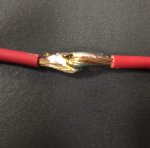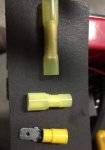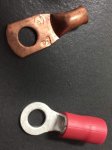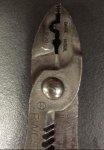V8srfun
Well-known member
- 423
- 539
- 93
- Location
- Altoona pa
I wanted to try and contribute something to the forum so here it goes
This is a basic soldering and wire connections walk thru
1. Disconnect your battery/batteries
This is for your safety and so you do not damage any thing. After all I don't think any of us are certified in 12 volt wielding
2. Inspect the wire you want to repair
If there is any corrosion or the wire does not look like fresh shiny copper cut it back until it does. If you do not start with clean corrosion free wire you are just asking for trouble and future headaches.
3. Be prepared
Have all your tools and what ever you need ready soldering is a meticulous task so there is no need to make it worse
4. Repair time
Now that we are ready now to perform the repair slip your heat shrink down one of the wires once you solder them you can't put it on. Now you can strip your wire casing back and connect the 2 pieces together. There are a couple ways you can put them together you can twist them like a bread tie, make both ends into j hooks and then squeeze them down , or mesh the wire together which I never have luck with because the strands usually bunch up and make a mess. What ever way you choose is irrelevant as long as the solder joint is good. Now get out your soldering iron and heat the wire from underneath. Do not heat the wire from the top. Now take your solder and push down on the wire lightly. What you are doing here is helping the heat transfer thru the iron to the wire. When the wire gets hot enough the solder will begin to melt. The solder should wick through the wire strands and encase all the exposed copper. When you have heated the wire and solder properly you can not over apply the solder as any excess will drop right off so do not be scared. Do not melt the solder on the iron to speed the process this will produce what is called a cold solder and will have high resistance be weak and essentially will be worthless.
Now that you have solders the wire let it cool this should not take long and inspect your repair. The solder should cover all of the exposed wire and be evenly dispersed. Note if you have your wire heated properly like instructed above you can apply the solder all in one spot and it will disperse itself throughout the wire. With that said if you are having trouble with the solder flowing chances are that you don't have enough heat in the wire. So now that you have a good looking solder joint with enough solder in it to properly conduct electricity you need to check the strength of the joint. Always pull test your joint and be fairly aggressive with this because it is easier to fix it now than later.
After inspection has passed you need to seal your solder joint the best way to do this is with heat shrink. There are 2 types of heat shrink. One is just that heat shrink and the other is self sealing heat shrink that has glue inside. Both of these are sufficient but If you do not have self sealing you need to apply a small amount of dielectric tune up grease to the solder to protect it before using the heat shrink. Then heat up the heat shrink until it has shrunk down and tightly wrapped around the wire.
Now I have a couple pics to show what all we have gone over
These two solder joints are what you want to look for you can see how the solder looks like it melted into the wire and has encased all of the exposed copper
i have a couple more posts to come after this one the way this forum posts pics it would be to hard to do this all in one post
This is a basic soldering and wire connections walk thru
1. Disconnect your battery/batteries
This is for your safety and so you do not damage any thing. After all I don't think any of us are certified in 12 volt wielding
2. Inspect the wire you want to repair
If there is any corrosion or the wire does not look like fresh shiny copper cut it back until it does. If you do not start with clean corrosion free wire you are just asking for trouble and future headaches.
3. Be prepared
Have all your tools and what ever you need ready soldering is a meticulous task so there is no need to make it worse
4. Repair time
Now that we are ready now to perform the repair slip your heat shrink down one of the wires once you solder them you can't put it on. Now you can strip your wire casing back and connect the 2 pieces together. There are a couple ways you can put them together you can twist them like a bread tie, make both ends into j hooks and then squeeze them down , or mesh the wire together which I never have luck with because the strands usually bunch up and make a mess. What ever way you choose is irrelevant as long as the solder joint is good. Now get out your soldering iron and heat the wire from underneath. Do not heat the wire from the top. Now take your solder and push down on the wire lightly. What you are doing here is helping the heat transfer thru the iron to the wire. When the wire gets hot enough the solder will begin to melt. The solder should wick through the wire strands and encase all the exposed copper. When you have heated the wire and solder properly you can not over apply the solder as any excess will drop right off so do not be scared. Do not melt the solder on the iron to speed the process this will produce what is called a cold solder and will have high resistance be weak and essentially will be worthless.
Now that you have solders the wire let it cool this should not take long and inspect your repair. The solder should cover all of the exposed wire and be evenly dispersed. Note if you have your wire heated properly like instructed above you can apply the solder all in one spot and it will disperse itself throughout the wire. With that said if you are having trouble with the solder flowing chances are that you don't have enough heat in the wire. So now that you have a good looking solder joint with enough solder in it to properly conduct electricity you need to check the strength of the joint. Always pull test your joint and be fairly aggressive with this because it is easier to fix it now than later.
After inspection has passed you need to seal your solder joint the best way to do this is with heat shrink. There are 2 types of heat shrink. One is just that heat shrink and the other is self sealing heat shrink that has glue inside. Both of these are sufficient but If you do not have self sealing you need to apply a small amount of dielectric tune up grease to the solder to protect it before using the heat shrink. Then heat up the heat shrink until it has shrunk down and tightly wrapped around the wire.
Now I have a couple pics to show what all we have gone over
These two solder joints are what you want to look for you can see how the solder looks like it melted into the wire and has encased all of the exposed copper
i have a couple more posts to come after this one the way this forum posts pics it would be to hard to do this all in one post
Attachments
-
38.1 KB Views: 79
-
34.8 KB Views: 77














